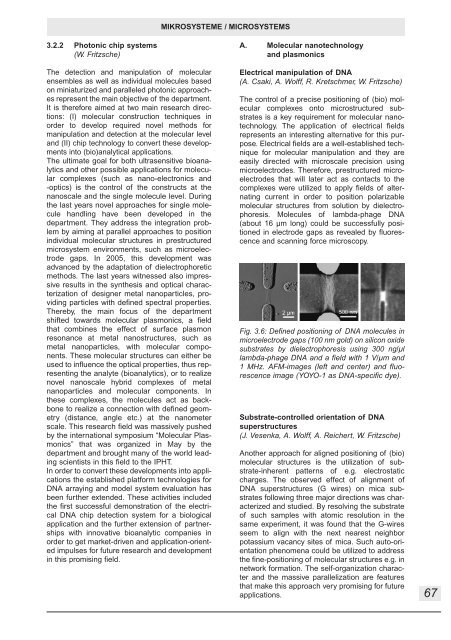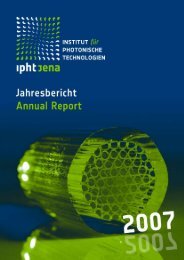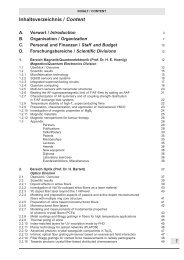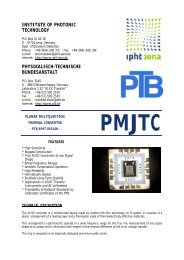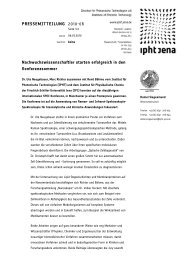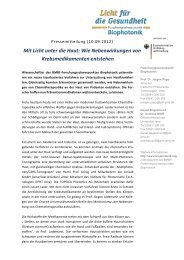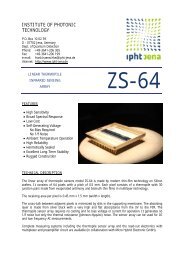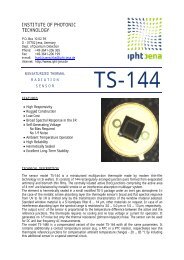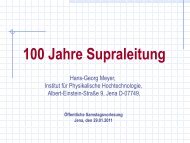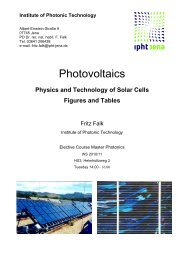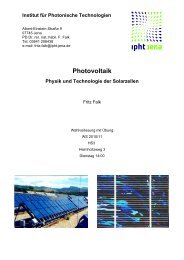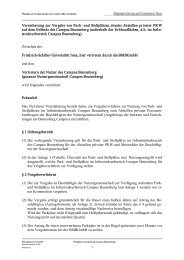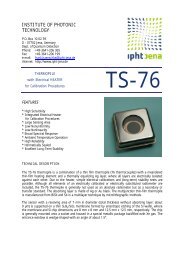Jahresbericht 2005 - IPHT Jena
Jahresbericht 2005 - IPHT Jena
Jahresbericht 2005 - IPHT Jena
Create successful ePaper yourself
Turn your PDF publications into a flip-book with our unique Google optimized e-Paper software.
3.2.2 Photonic chip systems<br />
(W. Fritzsche)<br />
The detection and manipulation of molecular<br />
ensembles as well as individual molecules based<br />
on miniaturized and paralleled photonic approaches<br />
represent the main objective of the department.<br />
It is therefore aimed at two main research directions:<br />
(I) molecular construction techniques in<br />
order to develop required novel methods for<br />
manipulation and detection at the molecular level<br />
and (II) chip technology to convert these developments<br />
into (bio)analytical applications.<br />
The ultimate goal for both ultrasensitive bioanalytics<br />
and other possible applications for molecular<br />
complexes (such as nano-electronics and<br />
-optics) is the control of the constructs at the<br />
nanoscale and the single molecule level. During<br />
the last years novel approaches for single molecule<br />
handling have been developed in the<br />
department. They address the integration problem<br />
by aiming at parallel approaches to position<br />
individual molecular structures in prestructured<br />
microsystem environments, such as microelectrode<br />
gaps. In <strong>2005</strong>, this development was<br />
advanced by the adaptation of dielectrophoretic<br />
methods. The last years witnessed also impressive<br />
results in the synthesis and optical characterization<br />
of designer metal nanoparticles, providing<br />
particles with defined spectral properties.<br />
Thereby, the main focus of the department<br />
shifted towards molecular plasmonics, a field<br />
that combines the effect of surface plasmon<br />
resonance at metal nanostructures, such as<br />
metal nanoparticles, with molecular components.<br />
These molecular structures can either be<br />
used to influence the optical properties, thus representing<br />
the analyte (bioanalytics), or to realize<br />
novel nanoscale hybrid complexes of metal<br />
nanoparticles and molecular components. In<br />
these complexes, the molecules act as backbone<br />
to realize a connection with defined geometry<br />
(distance, angle etc.) at the nanometer<br />
scale. This research field was massively pushed<br />
by the international symposium “Molecular Plasmonics”<br />
that was organized in May by the<br />
department and brought many of the world leading<br />
scientists in this field to the <strong>IPHT</strong>.<br />
In order to convert these developments into applications<br />
the established platform technologies for<br />
DNA arraying and model system evaluation has<br />
been further extended. These activities included<br />
the first successful demonstration of the electrical<br />
DNA chip detection system for a biological<br />
application and the further extension of partnerships<br />
with innovative bioanalytic companies in<br />
order to get market-driven and application-oriented<br />
impulses for future research and development<br />
in this promising field.<br />
MIKROSYSTEME / MICROSYSTEMS<br />
A. Molecular nanotechnology<br />
and plasmonics<br />
Electrical manipulation of DNA<br />
(A. Csaki, A. Wolff, R. Kretschmer, W. Fritzsche)<br />
The control of a precise positioning of (bio) molecular<br />
complexes onto microstructured substrates<br />
is a key requirement for molecular nanotechnology.<br />
The application of electrical fields<br />
represents an interesting alternative for this purpose.<br />
Electrical fields are a well-established technique<br />
for molecular manipulation and they are<br />
easily directed with microscale precision using<br />
microelectrodes. Therefore, prestructured microelectrodes<br />
that will later act as contacts to the<br />
complexes were utilized to apply fields of alternating<br />
current in order to position polarizable<br />
molecular structures from solution by dielectrophoresis.<br />
Molecules of lambda-phage DNA<br />
(about 16 µm long) could be successfully positioned<br />
in electrode gaps as revealed by fluorescence<br />
and scanning force microscopy.<br />
Fig. 3.6: Defined positioning of DNA molecules in<br />
microelectrode gaps (100 nm gold) on silicon oxide<br />
substrates by dielectrophoresis using 300 ng/µl<br />
lambda-phage DNA and a field with 1 V/µm and<br />
1 MHz. AFM-images (left and center) and fluorescence<br />
image (YOYO-1 as DNA-specific dye).<br />
Substrate-controlled orientation of DNA<br />
superstructures<br />
(J. Vesenka, A. Wolff, A. Reichert, W. Fritzsche)<br />
Another approach for aligned positioning of (bio)<br />
molecular structures is the utilization of substrate-inherent<br />
patterns of e.g. electrostatic<br />
charges. The observed effect of alignment of<br />
DNA superstructures (G wires) on mica substrates<br />
following three major directions was characterized<br />
and studied. By resolving the substrate<br />
of such samples with atomic resolution in the<br />
same experiment, it was found that the G-wires<br />
seem to align with the next nearest neighbor<br />
potassium vacancy sites of mica. Such auto-orientation<br />
phenomena could be utilized to address<br />
the fine-positioning of molecular structures e.g. in<br />
network formation. The self-organization character<br />
and the massive parallelization are features<br />
that make this approach very promising for future<br />
applications.<br />
67


